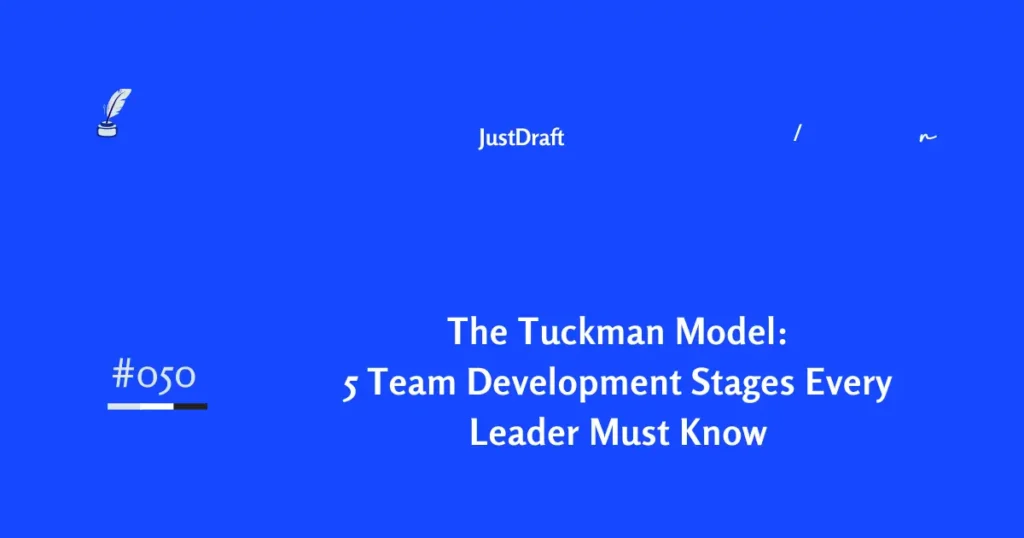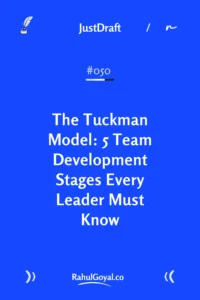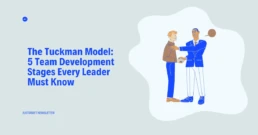Understanding the Tuckman Model for High-Performing Teams
Ever notice how some teams just click while others struggle for months?
Here’s the truth: high-performing teams aren’t born, they’re built through predictable stages and that what the Tuckman Model show us.
In 1965, psychologist Bruce Tuckman studied 50 research papers on group dynamics and found something remarkable. Every successful team goes through the same five stages, each with its own challenges and opportunities.
The problem? Most leaders don’t recognise which stage their team is in. They use the wrong leadership style at the wrong time, wondering why their team isn’t performing.
Let me show you how to read the signs and lead your team through each stage.
One Topic: The Tuckman Model – Navigating Team Development Stages
Stage 1: Forming (The Polite Phase)
You’ve just made a new team. Everyone’s on their best behaviour.
What you’ll see:
- Polite, cautious conversations
- People testing boundaries
- Heavy dependence on you for direction
- Lots of questions about roles and expectations
What’s really happening: Your team is operating at only 20-30% capacity. They’re excited but anxious. Nobody wants to rock the boat yet.
Your job as leader: Be directive. This isn’t the time for democratic decision-making.
Set clear goals. Define roles explicitly. Establish ground rules. Facilitate introductions that go beyond job titles.
Think of yourself as a tour guide. Your team needs structure and clarity before they can move forward.
Common mistake: Rushing this stage because things feel “fine.” That politeness is masking uncertainty that will surface later.
Duration: 2-4 weeks typically, but don’t cut it short.
Stage 2: Storming (The Reality Check)
Here’s where most teams struggle. Performance drops to 10-20% of capacity.
What you’ll see:
- Disagreements about approach or direction
- Power struggles for influence
- Frustration with pace or process
- Some team members becoming defensive
- Resistance to tasks or your leadership
What’s really happening: The honeymoon is over. People are showing their real personalities. Conflicts that were buried during forming are surfacing.
Here’s the key insight: this stage is necessary. Teams that avoid storming develop superficial relationships that collapse under pressure later.
Your job as leader: Switch to coaching mode. Don’t suppress conflict, manage it constructively.
Create psychological safety. Let people disagree without fear. Provide structure for working through tensions.
Coach your team on communication. Help them see conflict as data, not danger.
Common mistake: Either avoiding conflict entirely or letting it spiral out of control. Both approaches keep you stuck in storming.
The hard truth: About 30-40% of teams never make it past this stage. They either fall apart or settle into dysfunction.
Duration: 2-6 weeks, depending on how well you manage conflict.
Stage 3: Norming (Finding the Rhythm)
Relief. Your team is finally working together.
What you’ll see:
- Genuine cooperation emerging
- People accepting their roles
- Constructive feedback without defensiveness
- Growing commitment to shared goals
- Team identity forming
What’s really happening: Trust is building rapidly. Performance jumps to 50-70% of potential. Your team is establishing patterns and norms that will define how they work together.
Your job as leader: Step back gradually. Move to participative leadership.
Support collaborative decision-making. Reinforce productive behaviors. Celebrate progress. Start delegating more responsibility.
Think of yourself as a facilitator now, not a director.
Common mistake: Not reinforcing good norms when they emerge. Without reinforcement, teams can slip back to storming.
Watch for: Productivity increases by 50%+ during this stage as your team finds its groove.
Duration: 4-8 weeks as patterns solidify.
Stage 4: Performing (The Sweet Spot)
This is what you’ve been building toward.
What you’ll see:
- Collaborative problem-solving without your involvement
- High productivity sustained over time
- Team members supporting each other proactively
- Significant autonomy in decision-making
- Goals achieved efficiently
What’s really happening: Your team is operating at 80-95% of potential capacity. They’ve developed their own system. Trust is high. Leadership is often shared.
Your job as leader: Delegate extensively. Get out of the way.
Your role shifts from directing work to removing obstacles and providing resources. Focus on individual development. Champion the team to the rest of the organization.
The reality check: Only 40-60% of teams reach this stage. Many organizations don’t give teams enough time to develop, or they disrupt teams just as they hit their stride.
Common mistake: Micromanaging a performing team. If you’ve done the work in earlier stages, trust what you’ve built.
Duration: Ongoing, but fragile. Changes in membership or context can trigger regression.
Stage 5: Adjourning (The Ending)
Projects end. Teams disband. This stage matters more than most leaders realize.
What you’ll see:
- Nostalgia and reflection
- Bursts of extreme energy followed by low energy
- Humor (sometimes dark)
- Slowing momentum as the end approaches
What’s really happening: Your team is processing the transition. High performers often feel genuine grief about losing this working relationship.
Your job as leader: Be supportive. Facilitate proper closure.
Recognize achievements publicly. Capture lessons learned. Document best practices. Help team members carry their learning forward.
Common mistake: Letting teams just dissolve without acknowledgment. This leaves learning on the table and can decrease satisfaction for future team participation.
Duration: 1-2 weeks for proper closure.
What Great Leaders Do Differently
The real mastery lies in how leaders adapt at each stage:
| Stage | Leadership Style | Core Focus |
|---|---|---|
| Forming | Directing | Set clarity and purpose |
| Storming | Coaching | Manage conflict, build trust |
| Norming | Participating | Reinforce norms, encourage collaboration |
| Performing | Delegating | Empower autonomy, remove barriers |
| Adjourning | Supporting | Celebrate, reflect, and close |
Leadership isn’t static—it evolves with the team’s maturity.
Directive energy that helps during Forming becomes destructive if used during Performing.
When Teams Regress (And They Will)
Add a new team member? You’re back to storming.
Change leadership? Expect regression.
Major organisational shift? Your team will cycle back through earlier stages.
This isn’t failure. It’s normal.
The key is recognising regression quickly and adjusting your leadership approach. Don’t expect performing-level output from a team that’s re-storming.
The Practical Takeaway
Next time you’re frustrated with team performance, ask yourself:
“Which stage is my team actually in, and am I leading appropriately for that stage?”
Most leadership problems are actually diagnosis problems.
A team in storming doesn’t need more team-building activities. They need conflict resolution and psychological safety.
A team in performing doesn’t need more direction. They need autonomy and resources.
Know the stage. Lead accordingly.
Your Action Steps
This week, observe your team:
- Which behaviours from the five stages do you see most?
- What leadership style are you using currently?
- Does your style match your team’s developmental stage?
If there’s a mismatch, that’s your opportunity.
The research is clear: teams that navigate these stages systematically achieve 50%+ higher productivity and 14% better workplace performance.
But only if their leaders recognise where they are and adjust accordingly.
What stage is your team in right now?

Interested in travel, read last week’s LensLetter newsletter about Camera Kit Lens and When it’s Right Time to Upgrade.
Read last week’s JustDraft about The First Principle.
Two Quotes to Inspire
The quality of a team isn’t measured by the absence of conflict, but by how effectively they transform disagreement into progress.
eadership isn’t about maintaining the same approach—it’s about evolving your style as your team matures through each developmental stage.
One Passage From My Bookshelf
Not finance. Not strategy. Not technology. It is teamwork that remains the ultimate competitive advantage, both because it is so powerful and so rare. A friend of mine, the founder of a company that grew to a billion dollars in annual revenue, best expressed the power of teamwork when he once told me, “If you could get all the people in an organization rowing in the same direction, you could dominate any industry, in any market, against any competition, at any time.”
📚 From The Five Dysfunctions of a Team” by Patrick Lencioni


